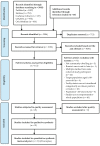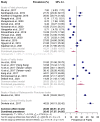Prevalence of Frailty among Community-Dwelling Older Adults in Asian Countries: A Systematic Review and Meta-Analysis
- PMID: 35628034
- PMCID: PMC9140771
- DOI: 10.3390/healthcare10050895
Prevalence of Frailty among Community-Dwelling Older Adults in Asian Countries: A Systematic Review and Meta-Analysis
Abstract
This study aimed to synthesize frailty prevalence among community-dwelling older adults in Asia and identify factors influencing prevalence estimates. Five electronic databases were searched by 29 April 2022, including representative samples of community-dwelling adults who were aged 60 years and older and lived in Asia. Cross-sectional or national longitudinal population-based cohort studies completed with validated instruments were selected. Twenty-one studies with 52,283 participants were included. The pooled prevalence rate of frailty was 20.5% (95% CI = 15.5% to 26.0%). The estimated frailty prevalence was 14.6% (95% CI = 10.9% to 18.8%) while assessed by the Fried frailty phenotype, 28.0% (95% CI = 21.3% to 35.3%) by the Cumulative Frailty Index, 36.4% (95% CI = 33.6% to 39.3%) by the Study of Osteoporotic Fractures (SOF) index, and 46.3% (95% CI = 40.1% to 52.4%) by the Clinical Frailty Scale (p < 0.01). Subgroup analysis in studies using the Fried’s phenotype tool found that frailty prevalence was increased with older age (p = 0.01) and was higher in those who were single (21.5%) than in married participants (9.0%) (p = 0.02). The study results supported a better understanding of frailty prevalence in different geographical distributions and provide references for health policy decision-making regarding preventing frailty progression in older adults.
Keywords: community dwelling; frailty; meta-analysis; older adults; prevalence; systematic review.
Conflict of interest statement
The authors declare no conflict of interest.
Figures




Similar articles
-
Global Incidence of Frailty and Prefrailty Among Community-Dwelling Older Adults: A Systematic Review and Meta-analysis.JAMA Netw Open. 2019 Aug 2;2(8):e198398. doi: 10.1001/jamanetworkopen.2019.8398. JAMA Netw Open. 2019. PMID: 31373653 Free PMC article.
-
Transitions of self-management behaviors and frailty status among community-dwelling older adults: a national longitudinal population-based cohort study.BMC Geriatr. 2022 Nov 18;22(1):874. doi: 10.1186/s12877-022-03578-3. BMC Geriatr. 2022. PMID: 36396993 Free PMC article.
-
Prevalence of frailty and associated factors among Saudi community-dwelling older adults: a cross-sectional study.BMC Geriatr. 2021 Mar 17;21(1):185. doi: 10.1186/s12877-021-02142-9. BMC Geriatr. 2021. PMID: 33731034 Free PMC article.
-
The Relationship between Metabolic Syndrome and Frailty in Older People: A Systematic Review and Meta-Analysis.Geriatrics (Basel). 2022 Jul 26;7(4):76. doi: 10.3390/geriatrics7040076. Geriatrics (Basel). 2022. PMID: 35893323 Free PMC article. Review.
-
Frailty Is a Major Related Factor for at Risk of Malnutrition in Community-Dwelling Older Adults.J Nurs Scholarsh. 2017 Jan;49(1):63-72. doi: 10.1111/jnu.12258. Epub 2016 Oct 25. J Nurs Scholarsh. 2017. PMID: 27779822
Cited by
-
Machine Learning Models for Frailty Classification of Older Adults in Northern Thailand: Model Development and Validation Study.JMIR Aging. 2025 Apr 2;8:e62942. doi: 10.2196/62942. JMIR Aging. 2025. PMID: 40262171 Free PMC article.
-
The efficacy of enhanced recovery program compared to routine care for patients undergoing knee replacement surgery: a systematic review and meta-analysis.BMC Musculoskelet Disord. 2025 Jul 4;26(1):636. doi: 10.1186/s12891-025-08547-6. BMC Musculoskelet Disord. 2025. PMID: 40615790 Free PMC article.
-
Literacy for Frailty among Undergraduate Medical Education: An Under-Recognized Opportunity to Improve Geriatric Care.Aging Dis. 2024 Aug 1;15(4):1482-1486. doi: 10.14336/AD.2023.0925. Aging Dis. 2024. PMID: 37815896 Free PMC article.
-
Comparative analysis of frailty identification tools in community services across the Asia-Pacific: A systematic review and meta-analysis.J Nutr Health Aging. 2025 Apr;29(4):100496. doi: 10.1016/j.jnha.2025.100496. Epub 2025 Jan 30. J Nutr Health Aging. 2025. PMID: 39889374 Free PMC article.
-
Inertial sensor-based gait classification for frailty status in older adults: A cross-sectional study.Comput Struct Biotechnol J. 2025 May 28;28:199-210. doi: 10.1016/j.csbj.2025.05.011. eCollection 2025. Comput Struct Biotechnol J. 2025. PMID: 40585381 Free PMC article.
References
-
- Vermeiren S., Vella-Azzopardi R., Beckwée D., Habbig A.-K., Scafoglieri A., Jansen B., Bautmans I., Bautmans I., Verté D., Beyer I., et al. Frailty and the Prediction of Negative Health Outcomes: A Meta-Analysis. J. Am. Med. Dir. Assoc. 2016;17:1163.e1–1163.e17. doi: 10.1016/j.jamda.2016.09.010. - DOI - PubMed
Publication types
LinkOut - more resources
Full Text Sources
Miscellaneous

